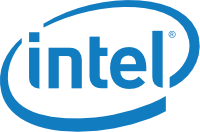Competition
The OLPC has sparked the creation of several other similar products that vary in their commerciability and their charitability. These primarily come from Intel, once a partner of OLPC, Microsoft, and India.
Intel

Initial Response
When Intel Chairman Craig Barrett first heard about the XO laptop, he did not believe the One Laptop Per Child project would be successful. He claimed that the developing world will not want a basic "hand-cranked" laptop. He argues that the XO laptop should not really be classified as a "laptop", but rather as a "$100 gadget". Historically, similar schemes and gadgets have not been successful. Barrett believes that
It turns out what people are looking for is something that has the full functionality of a PC. ... Reprogrammable to run all the applications of a grown-up PC ... not dependent on servers in the sky to deliver content and capability to them, not dependent for hand cracks for power.
Overall, he believes that users will be dissatisfied with the XO laptop's limited range of programs and functionality.
Intel agrees with the goals of the One Laptop Per Child project, just
not their implementation.
Barrett has stated that Intel is
still "committed to delivering IT access to the developing world."
Thus, they are helping Sri Lanka Telecom set up South Asia's first
long-distance WIMAX wireless network. However, Intel is not
interested in producing a cut-price computer like the XO as Intel works
in the area of "full-function PCs ... [n]ot handheld devices and not
gadgets." They were also starting projects in Sri Lanka to improve
computer literacy through an IT teacher-training program.
Collaborative Efforts
The OLPC mission of improving IT access in developing countries has been
adopted by many competitors. In an effort to improve upon the criticism
of the XO laptop using AMD chips and a Linux operating system, these
competitors have launched their own low-cost computers using the
industry standard of Intel chips and Microsoft Windows XP. Most notable
amongst these competitors is Intel, who launched their own low-cost
computer, the Classmate PC.
However, after years of disagreeing (and competing), Intel has decided
to join the OLPC project by donating millions of dollars to the project
and becoming a member of its board.
Splitting Ways
Unfortunately for One Laptop Per Child, Intel continued to promote and sell its Classmate PC in developing countries, thereby drawing much-needed sales away from OLPC. Intel has made deals to sell hundreds of thousands of Classmates in Nigeria, Libya, and Pakistan, countries that OLPC was counting on. Intel has also launched pilot programs in those three countries and is considering testing the Classmate in about 20 other countries, donation thousands of machines. Furthermore, according to OLPC Chairman Negroponte, Intel has marketing presentations suggesting that the Intel Classmate is far superior the One Laptop Per Child XO laptop, outperforming the XO in nine out of thirteen categories. This has further increases the sales of Classmates, to the detriment of the XO laptop. OLPC finds that they are unable to compete with Intel, who was still a member of their board, and that whenever they are near closing a deal with a country, Intel steps up its efforts and is actually successful in closing the deal.
Negroponte demanded that Intel stop undermining the OLPC project and its sales by ceasing to sell the rival computer. Intel refused to comply, and instead chose to remove themselves from the project.
When Intel refused, One Laptop Per Child project removed them from the board.
Nevertheless, Intel has continued to compete with the nonprofit, and it appears to be winning. It recently inked deals to sell hundreds of thousands of Classmates in Nigeria, Libya and Pakistan -- countries that Mr. Negroponte had been counting on. Intel has launched a series of pilot projects in those countries, and has said it will test the Classmate in at least 22 other nations, donating thousands of machines.
In recent months, Mr. Negroponte has abandoned his initial strategy of trying to persuade a half-dozen developing countries -- Argentina, Brazil, Libya, Nigeria, Pakistan and Thailand -- to buy one million laptops each. The project has begun accepting much smaller orders, and is attempting to persuade wealthier countries, including Italy and Spain, to finance laptops for poorer ones.
Microsoft

When Microsoft chairman and chief software architect Bill Gates first heard about OLPC's XO laptop, his initial reaction was to scoff. He commented on the fact that the laptop is lacking many features found on a typical computer, such as a hard disk and software:
The last thing you want to do for a shared-use computer is have it be something without a disk... and with a tiny little screen
He further notes that the laptop's cost is small part of the actual price for developing nations, adding that the main costs are network connectivity and support He supports the goals of the project, but much like Intel, doesn't agree with the implementation:
If you are going to go have people share the computer, get a broadband connection and have somebody there who can help support the user. Geez, get a decent computer where you can actually read the text and you're not sitting there cranking the thing while you're trying to type.
In response, Microsoft launched its own "ultra-mobile computer", which is expected to sell between $599 and $999.
India
In 2006, India decided not to become involved in the OLPC program. According to the Education Secretary Sudeep Banerjee, OLPC could not be taken seriously at that time. Banerjee also stated that the need for classrooms and teachers was greater than "fancy tools" and that if there were money available, it would be better spent on the existing education plans than attempting to implement OLPC in a pilot stage.
By 2008, India had begun its own attempts at creating low-cost laptops. Instead of OLPC's target price of $100 per laptop, the HRD ministry is aiming for a $10 laptop. Currently, there are two design ideas for the $10 laptop, and the expected cost is $47 per laptop.
